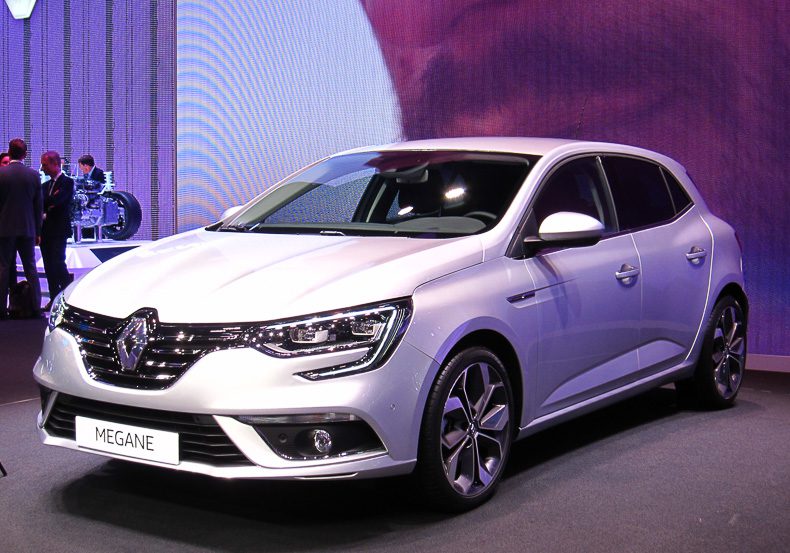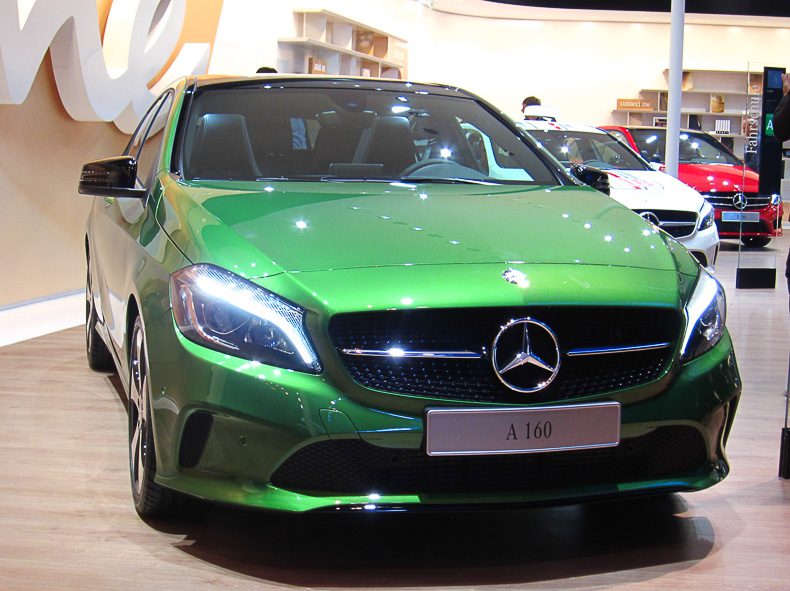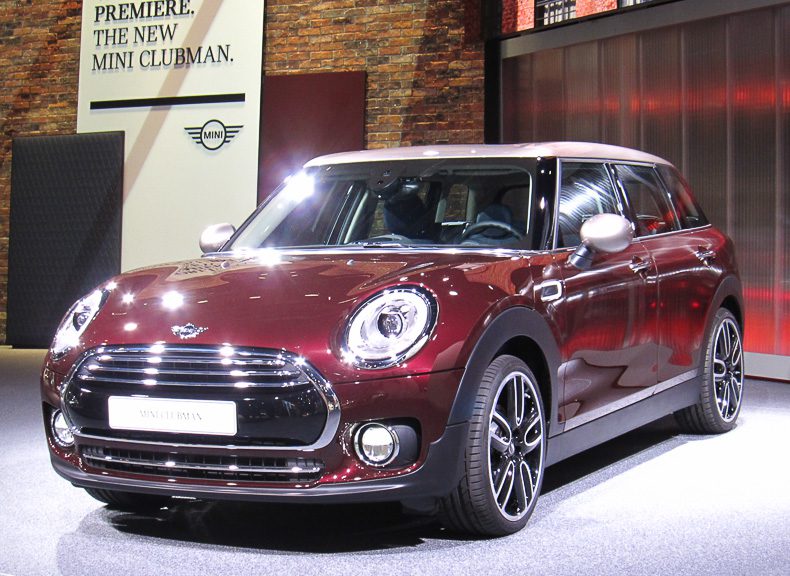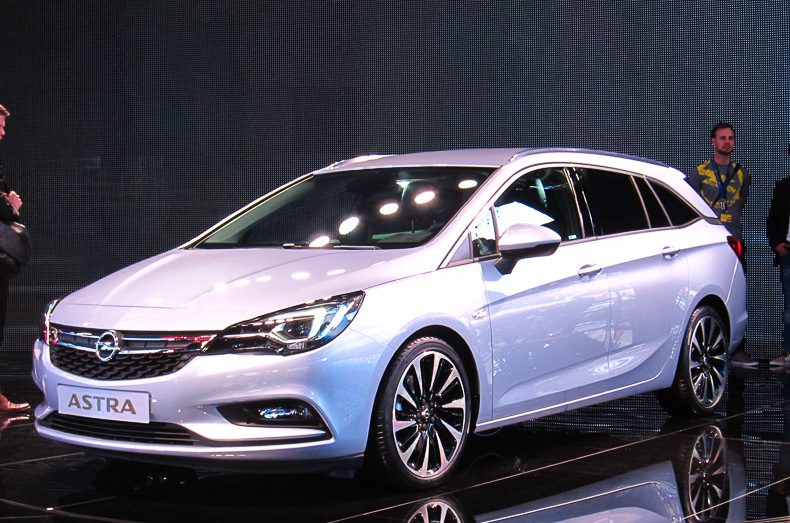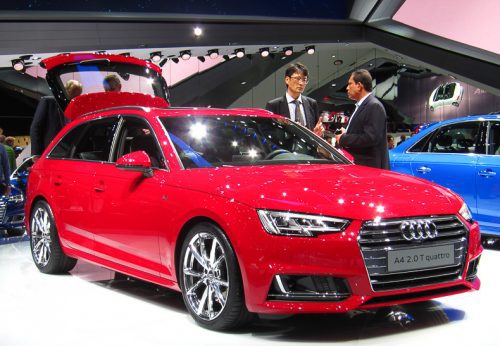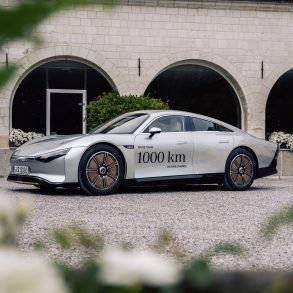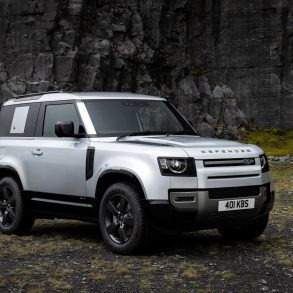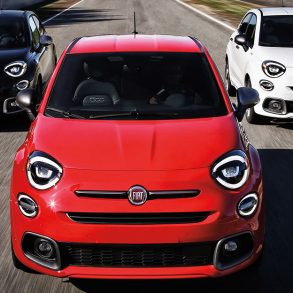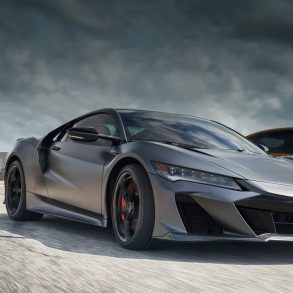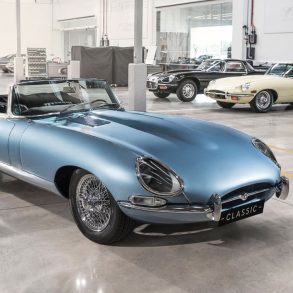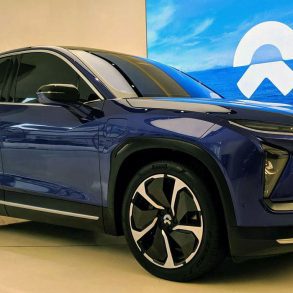Mercedes-Benz A-Class facelift
Mercedes-Benz revamped the A-Class, which features redesigned front and rear bumpers and is optionally available with LED High Performance headlamps. From the beginning of 2016 Apple CarPlay and MirrorLink will become available. The refreshed Mercedes-Benz A-Class comes with a range of no less than eight petrol engines, oddly with only two displacements: a 1.6-litre four-cylinder (A 160, A 180 , A 180 BlueEFFICIENCY Edition & A 200) and a 2.0-litre four-cylinder (A 220, A 250, A 250 Sport and A 45 AMG) engine. The A 160 with 102 hp is the new entry-level model. It consumes 5.1 l/100 km (CO2-emissions 119 g/km) when opting for the 7G-DCT dual-clutch transmission, the manual version is slightly less efficient. The diesel range consists of five engines with two displacements: the 1.5-litre Renault engine is offered in the A 160 d, A 180 d and A 180 d BlueEFFICIENCY Edition, while the 2.2-litre Mercedes engine powers the A 200 d and A 220 d. Fuel consumption of the A 180 d BlueEFFIENCY Edition has been reduced slightly to 3.5 l/100 km (CO2-emissions 89 g/km). The A 220 d now offers 177 hp (+ 7 hp). The A 250 Sport now has an additional 7 hp (218 hp) over the regular A 250. Mercedes-Benz was slightly jealous seeing the Audi RS3 dethroning the A 45 AMG (“The best or nothing”, right?), so it has improved the performance of high-performance even further. The four-cylinder engine develops 381 hp (+ 21 hp) and a maximum torque of 475 Nm. Thanks to faster gear ratios, aerodynamic fine-tuning and the Dynamic Select driving mode it launches the A 45 AMG from 0 to 100 km/h in 4.2 seconds, 0.4 seconds than its predecessor.
Mercedes-Benz C-Class Coupé
Another debut is the new Mercedes-Benz C-Class Coupé. In terms of looks, it’s almost a baby S-Class Coupé. Compared to its predecessor, the wheelbase is 80 mm longer, while overall car length has been increased by 95 mm and its width is 40 mm larger, which also means that it is now uncomfortably close to the E-Class Coupé in terms of size: the C-Class Coupé is both wider and has a longer wheelbase. It comes with a wide range of engines: the C 180 (156 hp), C 200 (184 hp), C 250 (211 hp), C 300 (245 hp), C 63 AMG (476 hp) and C 63 AMG S (510 hp) petrol engines and C 220 d (170 hp) and C 250 d (204 hp) diesel engines. The latter one is powered by a 4,0-litre twin turbo. Acceleration from 0 to 100 km/h takes just 4.0 seconds, or 3.9 seconds in the C 63 AMG S.
Mercedes-Benz S-Class Cabriolet
After an absence of 44 years, the S-Class Cabriolet makes its return. The new S-Class Cabriolet is based on the S-Class Coupé that was launched during spring 2014. It adopts around 60 percent of the bodyshell components from the Coupé. Wheelbase of 2,945 mm, overall length of 5,027 mm and width of 1,899 mm are identical to the Coupé, while its height is 6 mm larger at 1,417 mm. Drag of the cabriolet is 0.29 Cd and fifty percent of the surface area is produced in aluminium. It features a rear wall behind the rear seats, which serves to reinforce the body, supports the pyrotechnically extending roll bars and incorporates a through-loading opening into the luggage compartment. Numerous reinforcements on the underfloor should enhance the rigidity of the four-seater cabriolet. The car is fitted with the Aircap automatic wind protection system and Airscarf neck-level heating system as standard. The Mercedes-Benz S-Class Cabriolet is available with two petrol engines: the S 500 (455 hp) and S 63 AMG (585 hp).
Mini Clubman
The new Mini Clubman might have lost some of its distinctive character; in turn the Clubman is significantly more spacious than its predecessor. The wheelbase measures 2,670 mm, length is 4,253 mm, width 1,800 mm and height 1,441 millimetres, which means its wheelbase is 10 cm longer than the Mini 5-door, total length is 27 cm larger and surprisingly it is also 9 cm wider. The Clubman’s two laterally opening split doors at the rear, hinting at the original Austin Seven Countryman and Morris Mini Traveller, are gone and replaced by one wing door, which also houses the new horizontally oriented rear lights. The luggage compartment has a volume of 360 litres, which can be further increased to 1,250 litres. The engine portfolio starts with the Mini One Clubman with a 1.5-litre 3-cylinder engine producing 102 hp of power and 180 Nm of torque. Fuel consumption is 5.1 l/100 km and corresponding CO2-emissions 119 g/km. The more powerful Cooper Clubman is powered by the same unit, now producing 136 hp of power and 220-230 Nm torque, while its fuel consumption and CO2-emissions are 5.1 l/100 km and 118 g/km respectively. More power is offered by the Cooper S that houses a 2.0-litre 4-cylinder engine with a peak output of 192 hp and 280-300 Nm torque. It uses 5.8 /100 km of fuel when choosing the 8-speed Steptronic automatic transmission (CO2-emissions 134 g/km), the manual version is slightly less efficient. De diesel range starts with the One D with a 1,5-litre 3-cylinder diesel engine producing 116 hp of power, 270 Nm of torque and uses 3.8 l/100 km of fuel, which corresponds with CO2-emissions of 99 g/km. The mid-range Cooper D houses the 2.0-litre 4-cylinder diesel engine, producing 150 hp/330 Nm, average fuel consumption of 4.1 l/100 km and CO2-emissions of 109 g/km. The Cooper SD with the same four-cylinder drivetrain produces 190 hp. Versions mated to an automatic transmission are most efficient, with fuel consumption and CO2-emissions of 4.3 l/100 km and 114 g/km respectively. Optional driver assistance systems include the Head-Up Display and the Driver Assistant system including camera-based active cruise control, collision and pedestrian warning with initial brake function, high beam assistant, road sign detection, Parking Assistant and rear view camera.
Opel Astra
In terms of sales the all-new Opel Astra is one of the most important debuts at the IAA Frankfurt. The old Astra was handicapped by its hefty weight, something Opel has addressed by making the new generation up to 200 kilograms lighter. The body-in-white weight alone was reduced from 357 kg to 280 kg, the new chassis is 50 kg lighter, while engines, exhaust system, smaller wheels and tyres and smaller brakes with better braking performance further contributed to the weight reduction. The weight reduction should have resulted in improved agility and driving comfort. With a total length of 4,370 millimetres, the car is 49 mm smaller than its predecessor, while its width of 1,809 mm is 5 mm smaller and height is 25 mm smaller to 1,485 mm. Its wheelbase of 2,662 mm is also 23 mm smaller than before, while the hatchback retained its boot space of 370 litres.
The new Astra Sports Tourer is 4 mm longer than its predecessor to 4,702 mm, its height is 1,499 mm and its luggage capacity is up to 1,630 litres. It has a drag coefficient of 0.285, compared with 0.325 for the outgoing model. Even though the wheelbase is smaller than before, rear passengers benefit from a 35 mm (Sports Tourer: 28 mm) larger rear legroom. Compared to the new Renault Mégane it offers notably more legroom for rear passengers. A novelty for the model includes the optionally available IntelliLux LED matrix lights, while it comes with safety assistance systems like traffic sign assist, lane keep assist with automatic steering correction and front collision alert with autonomous emergency braking. The engine range starts with the three-cylinder 1.0 Turbo engine, which is new to the Astra. Its power output is 105 hp, while fuel consumption and CO2-emissions are just 4.2 l/100 km and 96 g/km respectively when coupled with the Easymatic automated manual transmission.
In selected countries it is also available with the normally aspired 1.4-litre engine, producing 100 hp. The 1.4 Turbo engine comes in 125 hp and 150 hp power outputs, with fuel consumption of 4.9 l/100 km and CO2-emissions of 114 g/km. The 1.6 Turbo with 200 hp of power and 300 Nm torque is the top-of-the-range engine available. The 1.6 CDTI is the sole diesel engine available, with power outputs of 95 hp, 110 hp and 136 hp, while the BiTurbo delivers 160 hp of power and CO2-emissions of just 108 g/km. The most efficient 1.6 CDTi version currently uses 3.4 l/100 km of fuel and emits 90 g/km of CO2, while a more frugal ecoFLEX with CO2-emissions of 82 g/km will be launched soon. Next year Opel will launch the new Astra sedan; the GTC is likely to be phased out, while the Opel Cascada cabriolet still has many years ahead before an eventual replacement will be launched.
Opel Vivaro Surf Edition
Although it is officially still a concept car, the Opel Vivaro Surf Edition has ‘series production potential’ according to Opel. The Surf Edition is painted in copper-brown and white paint and foliation and has a special surfboard bracket. The air suspension of the rear axle should provide for extra ride comfort and in combination with the shortened springs, it reduces the vehicle’s height by seven centimetres to 1.90 metres. It can seat five to six passengers and offers a separate cargo area of 3.2 cubic metres – or 4.0 cubic metres for the long wheelbase version.
Peugeot 308 GTi
Peugeot unveiled the new 308 GTi by Peugeot Sport, the more extreme performance orientated ‘hot hatch’ compared to the 308 GT. The 308 GTi sits 11 millimetres lower to the ground than the standard 308. The nose features full LED headlamps, a black radiator grille and air intake and two front spoilers below the bumpers. Enhancements to the profile of the car include redesigned door sills, while the rear design features a gloss-black section housing the twin exhaust pipes. The interior features GTi signatures, sports seats. The Peugeot 308 GTi is powered by the 1.6-litre THP petrol engine and comes in 250 hp and 270 hp power outputs, while still emitting only 139 g/km of CO2. The 308 GTi 270 should be able to accelerate from 0 to 100 km/h in 6.0 seconds flat (GTi 250: 6.2 seconds).
Porsche 911 facelift
In Frankfurt Porsche unveiled the updated 911 Carrera and Carrera S, which are powered by a new 3.0-litre turbocharged six-cylinder engine replacing the normally aspired 3.4-litre Carrera and 3.8-litre Carrera S engines. The engine in the Carrera now delivers 370 hp and the Carrera S 420 hp. This represents in both cases a power increase of 20 hp. Maximum torque of 450 Nm and 500 Nm is an increase of 60 Nm. The new engine generation is almost twelve percent more efficient. The Porsche 911 Carrera with PDK double-clutch transmission now consumes 7.4 litres per 100 kilometre of fuel (CO2-emissions 169 g/km), the Carrera S with PDK 7.7 l/100 km (CO2-emissions 174 g/km). The 911 Carrera Coupé and 911 Carrera S Coupé with PDK and Sport Chrono Package sprint from zero to 100 km/h in 4.2 seconds and 3.9 seconds respectively, both two tenths of a seconds faster than its predecessor, while top speed has been increased as well to 295 km/h and 308 km/h. Visual updates on the exterior include new headlights and rear lights, door handles without recess covers and a rear lid with vertical louvres. The Porsche Active Suspension Management now comes as standard, as well as the Porsche Communication Management System.
Renault Mégane
Renault launched no less than two all-new models in Frankfurt: the fourth generation Mégane and the Talisman. Both models are using the new CMF modular architecture. The new Renault Mégane is 64 mm longer (4,359 mm) and 25 mm lower (1,447 mm) than the third-generation model, and has a 28 mm longer wheelbase. It offers knee room of 175 mm (+ 20 mm) and its boot capacity of 434 litres is the second largest in its class according to Renault, however its cabin space doesn’t impress. The new model will be available with three diesel engines and three petrol engines. The petrol range consists of the 1.2-litre TCe 100 and TCe 130, and the 1.6-litre TCe 205 which is only available in the Mégane GT. The 1.5-litre dCi 90 and dCi 110 start the diesel range and is followed by the 1.6-litre dCi 130. The most efficient version has CO2-emissions of 86 g/km. The dCi 110 can optionally be paired with an automatic EDC six-speed dual-clutch automatic transmission.
In 2016 the 1.6-litre twin two dCi 165 will be added to the range, which will also become available in the GT. In early 2017 a Hybrid Assist will be added, with combined fuel consumption below 3 litres per 100 km and CO2-emissions of 76 g/km, which would turn it into the most efficient diesel-powered car in its class. The Hybrid Assist achieves these numbers by capturing energy under deceleration and braking. The new Mégane features LED headlights, while higher-end versions feature Pure Vision LED technology. The fit and quality of materials of the interior have been improved. New technologies of the Mégane include the retractable colour head-up display and Multi-Sense with five different driving modes.
The Mégane GT is powered by a 1,6-litre turbo petrol engine mated to an EDC seven-speed dual-clutch automatic gearbox and produces 205 hp of power. It is recognizable from the lower-end versions by the new front with a special design for upper and lower grilles and rear bumper with a diffuser. The Mégane GT is also the first C-segment model to feature 4Control four-wheel-steer technology. The GT’s chassis have recalibrated dampers, springs, ESC and brakes as well. The Mégane Coupé will remain in production for a while, but won’t get a successor. The range-topping RS will solider on until the end of next year. The new Mégane Estate will follow soon and the Renault Fluence, essentially a sedan variant of the Mégane, will probably be released next year.
Renault Talisman
The new Talisman replaces the slow-selling Renault Laguna and Latitude. The Renault Talisman, which has mostly been developed by Renault-Samsung in South Korea, is available in sedan and Estate bodyworks. Safety features include the Advanced Driver Assistance System, which is available with Adaptive Cruise Control, Active Emergency Braking System, Safe Distance Warning, Traffic Sign Recognition with Over Speed Prevention and Blind Spot Warning, a reversing camera and a retractable head-up display.
Like the new Mégane, the Talisman is also optionally available with 4Control four-wheel steering with active damping and Multi-Sense technology with four different driving modes. The Talisman is available with 1.6-litre petrol and diesel engines. The TCe 150 and TCe 200 petrol engines are standard mated to a seven-speed automatic EDC dual-clutch transmission. The three diesel engines are the dCi 110, dCi 130 and dCi 160, the latter one is standard mated to a six-speed EDC, while the transmission is optionally available on the 110 and 130. The Talisman’s CO2-emissions are as low as 95 g/km. The Talisman’s boot capacity is 608 litres, while the Talisman Estate offers 572 litres, which can be extended to 1,700 litres with the rear seats folded.
Rear passengers have 262 mm of knee room and the car indeed impresses with its cabin space, attributed by its generous wheelbase of 2.87 metres. Overall length of the Talisman is 4.85 metres (Estate: 4.86 metres), width is 1.87 metres and its height measures 1.46 metres. Like the Renault Espace and Clio Estate, the new Talisman won’t be sold in markets like the United Kingdom and Ireland.
Rolls-Royce Dawn
Rolls-Royce launched its ‘entry model’ Drophead Coupé (cabriolet) Dawn in Frankfurt, which is based on the Ghost and Wraith, although 80 percent of the body panels are new. At the front, it features for instance a grille that is recessed by 45 mm whilst the lower front bumper has been extended by 53 mm compared to the Wraith. The Dawn is as luxurious as those models with a fixed roof and offers seating for four people. The actual opening and closing of the roof mechanism both take place in 22 seconds. The Dawn is powered by a 6.6-litre V12 engine, producing 563 hp of power and 780 Nm torque. It accelerates from zero to 100 km/h in just 4.9 seconds and has an electronically limited top speed of 250 km/h. Average fuel consumption is 14.2 l/100 km and its CO2-emissions 330 g/km.
Skoda Superb Combi
The news at the Skoda stand focused around the new Superb Combi, the estate model of its flagship model. By the end of May, Skoda delivered more than 200,000 Superb Combis to customers worldwide, which represents 35 percent of Superbs sold since 2009. The Superb Combi is renown for its generous space inside, and the new generation offers even more space. Its boot capacity has been increased by 27 litres to 660 litres and offers rear legroom of 157 mm. The new Skoda Superb Combi has seen a reduction in vehicle weight of up to 75 kilograms thanks to the MQB platform. Combined with improved aerodynamics and enhanced engines, the drivetrains are up to 30 percent more efficient. Five TSI petrol and three TDI diesel engine are available: petrol engines range produce between 125 hp and 280 hp, the diesel engines range from 120 hp to 190 hp. The most efficient version is the 1.6 TDI GreenLine that consumes 3.7 l/100 km and emits 96 g/km CO2. The two most powerful petrol and diesel engines are available will all-wheel drive.
Smart Fortwo Cabrio
It has been over a year since Smart launched the third-generation of its Fortwo two-seater, at the IAA Frankfurt the brand unveiled the new Fortwo Cabrio. The Smart Fortwo Cabrio, the smallest production cabriolet on the market with its length of 2.69 metres, features a ‘tritop’ fabric soft top, which can be opened automatically in twelve seconds. The side roof bars can be removed and stowed on the inside of the tailgate. The Fortwo Cabrio’s torsional strength has been improved by around 15% compared to its predecessor. It is powered by the three-cylinder 1.0-litre 71 hp or 0.9-litre 90 hp petrol units, which are mated to either a five-speed manual transmission or the twinamic automatic dual-clutch transmission. The new Fortwo Cabrio will be available for ordering from mid-November, with first models reaching dealerships in February 2016.
Suzuki Baleno
The Baleno joins the Swift as the second B-segment offering of Suzuki. Like the Swift, Vitara and SX4 S-Cross, the Baleno will be produced in Hungary for the European market. It focuses more on space, measuring 4,023 mm in length and height of 1,450 mm. Its wheelbase of 2,520 mm is 90 mm larger than that of the Swift and its boot capacity of 355 litres is the largest in class according to Suzuki. It offers impressive legroom for rear passengers as well. Competitors include the Hyundai i20, Renault Clio, Skoda Fabia and Toyota Yaris. The Baleno can be equipped with safety features like Adaptive Cruise Control and Radar Brake Support.
The new Suzuki Baleno comes with two petrol options. The 1.2 DualJet has been fitted with Suzuki’s SHVS mild hybrid system that uses an ISG (Integrated Starter Generator) to assist the engine during acceleration and also generates electricity to the lithium-ion battery through regenerative braking. Said solutions have reduced CO2-emissions to 93 g/km. The engine can be paired with a five-speed manual transmission or CVT automatic transmission. The 1.0 BoosterJet with turbocharger and direct-injection has a maximum output of 112 hp and maximum torque of 170 Nm and can be paired to the five-speed manual gearbox or six-speed automatic transmission. It remains to be seen if Suzuki will launch a diesel-powered Baleno as well.
Toyota Prius
Toyota launched the fourth generation of its Prius, the hybrid pioneer. Since 1997 Toyota managed to sell more than 3.5 million units of the Prius, while Toyota hybrids still make up more than 50 percent of all the alternative powertrain vehicles sold in Europe. The new Toyota Prius is the first model to use a Toyota New Global Architecture (TNGA) platform, which gives the Prius a lower centre of gravity and improved driving position, improved driving dynamics, a 60 percent more rigid body and improved safety. The new Prius retains the 2,700 mm wheelbase of the current Prius, but is also 60 mm longer overall at 4,540 mm and 15 mm wider at 1,760 mm. Its height is 1,470 mm. Thanks to the use of a smaller, a more energy-dense hybrid battery, and a new double wishbone rear suspension, its trunk capacity has been improved as well.
Its exterior design is rather controversial, but its interior has unmistakably been improved, with an improved sensory quality, the instrument panel is now finished in piano black, while other areas of the dashboard and door panels have been finished in a white material. Toyota promises an improvement of 18 percent in fuel economy over the current car, which should make it even more efficient than the Yaris Hybrid. A Pre-Crash Safety system, Lane Departure Alert, Automatic High Beam and Road Sign Assist are standard safety features, a radar-governed Adaptive Cruise Control and Pre-Collision Safety system are also available.
Volkswagen Golf Sportsvan R-Line
The Volkswagen Golf Sportsvan (or Golf SV in Britain) is a capable people carrier, but it could quite use some extra spice to turn it into something resembling a ‘sportsvan’. Volkswagen addresses that with the launch of the R-Line packages for the model. Buyers can opt for both the R-Line Exterior package and interior package or independently, as well as the R-Line Sports package that includes progressive steering, tinted passenger compartment windows (darkened by 65 percent and sports suspension (body 15 mm lower). The exterior package features redesigned bumpers with ventilation grilles and chrome elements, a diffuser at the back, as well as chrome plated exhaust tailpipes, darkened taillights and sill extensions. Its interior features sports seats and R-Line specific details and the usage of aluminium for door sills, pedals, foot rest and gear knob.

